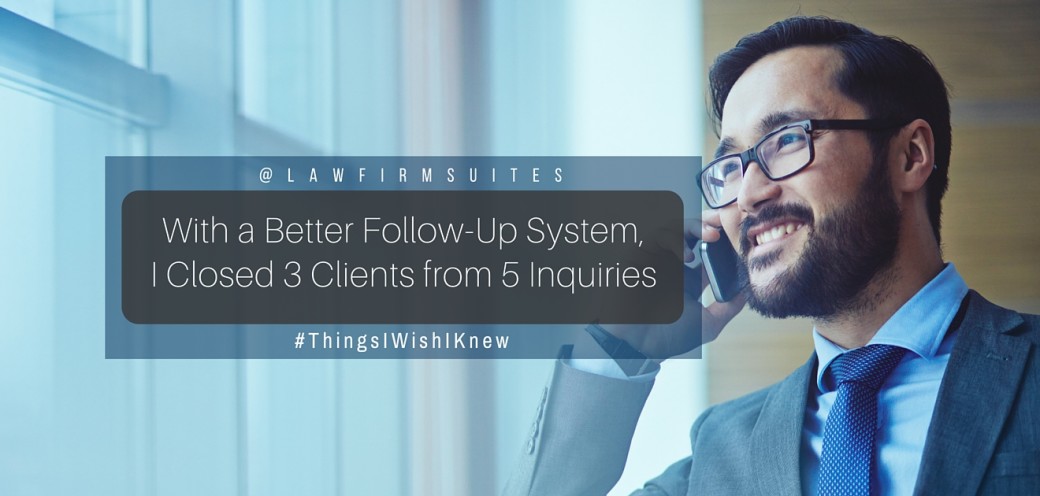In this week’s edition of Things I Wish I Knew, Joleena Louis discusses a recent change she made with her follow-up system for prospective clients and how it’s increasing profits in her practice.
My focus this year has been to increase my profits by bringing in new clients.
I’ve examined my processes and learned that my biggest weakness is following up on phone and email inquiries. After the initial phone call or exchange of emails, I was leaving it up to the prospective client to contact me if there were still interested.
I’ve always had a good system in place for consultations; most prospects who come in for a consultation retain me, unless I don’t want the case. But I realized I don’t have a system for following up with prospective clients after an initial inquiry and, as a result, I’m not closing enough people people who don’t schedule a consult after the initial phone call or email conversation.
I think the biggest reason behind this weakness is my fear of being too pushy.
If a prospective client takes the time and effort to come in for a consultation, I feel more comfortable following up with them because we have established a relationship and they have already expressed interest. If I get an email or phone inquiry and they are not ready to schedule a consultation, I just assumed they weren’t interested and left it alone.
This was a big mistake. I was not optimizing all the hard work I put into lead generation, making my marketing time much less efficient.
Not following up with prospects can result in loss of revenue. Click To TweetSimilar to learning how to ask for referrals, I had to get over the fear and found non-pushy ways to follow-up.
Here’s what I’m doing:
1. I Follow Up in Writing
I find that emails or letters are non-pushy ways to follow-up because it does not invade the recipient’s time or make them feel pressure to return a call or voicemail.
It also makes it easier to start with a template that you can personalize based on the recipient, and they will have all of my contact information in writing.
2. I Try to Make It Personal
Sending a generic follow-up email that I could just copy and paste for everyone seemed like the easiest route, but this type of email would likely be ignored.
Instead, I send one stellar follow-up instead of a few that are mediocre; personalization is key. Bringing up some of their concerns or summarizing what we discussed will makes my follow-up email worthy of their attention.
3. My Goal is to Add Value
At the end of a phone inquiry I ask for a prospective client’s email to send them some resources I think they would find useful.
This is a great way for me to personalize the follow-up communication and makes the communication more about me helping them rather than me selling to them. It creates an experience that is valuable and keeps my services in mind.
4. I Do it Right Away
Part of my problem with follow-up communications is that I forget. I always have a lot going on so it’s easy to forget a phone call after it’s concluded. An easy solution was for me to immediately write the email or letter and send it right away.
I may also start to use an email scheduler where I can write the follow-up email immediately, but have it sent at a later time. You can do this with the Delay Delivery tool if you use Outlook, using a free app like Hubspot Sales, or this trick using a Google Sheet.
#Lawyers: follow-ups are key to closing business. Click To Tweet5. I Let Them Know About Next Steps
In my follow-up message, I always include the steps they need to take when they are ready to schedule a consultation. Explaining this by email is very useful because they can save it and reference it later when they are ready to move forward.
6. I Keep It On Brand
Every brand has something that makes them unique. All of your communications should reflect you, your business, and the quality of service you provide.
My brand strives to be paperless so I send an email over a letter. But maybe your brand would benefit from a handwritten note instead? Or even a phone call to make a vocal connection?
My brand is also very focused on creating a personalized experience. In my follow-up communication I try to include specific resources that address a concern we discussed.
Since April I’ve had the opportunity to try these follow-up strategies on five people. Two did not respond, two scheduled consultations and one was still not ready to move forward but referred her sister. Follow-up communications take a little extra time, but with results like these it’s worth it in the end.
What do you do to follow-up with prospective clients? Comment below and tell us what you think!


